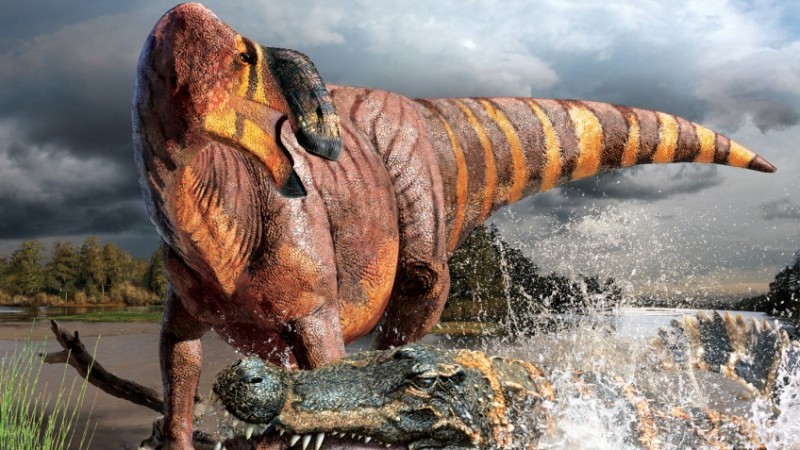
The newly discovered hadrosaur, Rhinorex condrupus, has is characterised by its large nose(Julius Csotonyi)
Posted on 09/23/2014 11:59:55 AM PDT by Red Badger
Palaeontologists have discovered what they are calling the "Jimmy Durante" of dinosaurs, a type of hadrosaur with a distinctive nasal profile.
Named Rhinorex condrupus, the fossil was found by researchers from North Carolina State University and Brigham Young University, and lived in what is now Utah approximately 75 million years ago during the Late Cretaceous period.
According to National Geographic, the date places the creature in the middle of a major dinosaur radiation, the process by which species adapt to new ecological niches.
Rhinorex, which translates roughly into "King Nose", was a plant-eater and a close relative of other Cretaceous hadrosaurs like Parasaurolophus and Edmontosaurus.
Hadrosaurs were common herbivores, found across what is now Asia, Europe and North America.
Although the dinosaurs are usually identified by bony crests that extend from the skull, Rhinorex has a different defining feature – a huge nose.
Terry Gates, a joint postdoctoral researcher with North Carolina State University and the North Carolina Museum of Natural Sciences, and Rodney Sheetz, of the Brigham Young Museum, came across the fossil in storage at BYU.
First excavated in the 1990s from Utah's Neslen formation, when Gates and Sheez reconstructed the skull, they realised they had a new species.
"We had almost the entire skull, which was wonderful," Gates said. "But the preparation was very difficult. It took two years to dig the fossil out of the sandstone it was embedded in -- it was like digging a dinosaur skull out of a concrete driveway."
Based on the recovered bones, Gates estimates that Rhinorex was about 30 feet long and weighed over 8,500 lbs.
Rhinorex, which thrived in a swampy estuarial environment around 50 miles from the coast, is the only complete hadrosaur fossil from the Neslen site.
"We've found other hadrosaurs from the same time period but located about 200 miles farther south that are adapted to a different environment," Gates told the Tech Times.
"This discovery gives us a geographic snapshot of the Cretaceous, and helps us place contemporary species in their correct time and place. Rhinorex also helps us further fill in the hadrosaur family tree."
Gates said the reason for the dinosaur's large nose was not yet understood.
"The purpose of such a big nose is still a mystery," he said.
"If this dinosaur is anything like its relatives then it likely did not have a super sense of smell; but maybe the nose was used as a means of attracting mates, recognizing members of its species, or even as a large attachment for a plant-smashing beak. We are already sniffing out answers to these questions."
The research was published in the Journal of Systematic Palaeontology.

The newly discovered hadrosaur, Rhinorex condrupus, has is characterised by its large nose(Julius Csotonyi)
Rhinorex condrupus annie.
Gator got your granny, chomp, chomp chomp.
It was just eatin’ some Poke Salad................
This place is a zoo!
“I got a million of ‘em!”
Wanted to say Thanks for some good news but is this good news? The picture says otherwise.
“Hot-cha-cha-cha”
Good nite, Mrs. Calasauros!
Oh, Yes! The late, great Jerry Reed.....
Died of a nosebleed.
Statuette of a Frog?
Now that’s polk... salad (not poke).

Nope. A rhinovirus...........
Well, it’s been dead for 75 million years. Time to move on............
“Everybody wants to get into the act!”
Heck out there in the time / space continuum on a planet 75 million light years away ... they haven't been informed yet.
The croc will swallow you whole.
http://www.australiazoo.com.au/about-us/zoo-gossip/images/973_one_600.jpg
Disclaimer: Opinions posted on Free Republic are those of the individual posters and do not necessarily represent the opinion of Free Republic or its management. All materials posted herein are protected by copyright law and the exemption for fair use of copyrighted works.